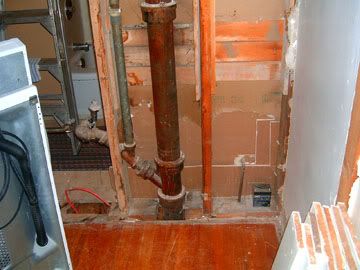 |
|
| Browse | Ask | Answer | Search | Join/Login |
|
|
||||
|
Cast iron pipe installation
In my bungalow, I would like to rotate a 4" cast iron "Y" 180 degrees, which is inserted on a verticle wet/dry vent. Can this be done by heating the lead and turning the "Y" in the position required. All the walls have been removed to remodel the bathroom. So I can use leverage to turn the "Y"
Thanks Luc |
||||
|
||||
|
Cast iron pipe installation
Hey luc,
I can use leverage to turn the "Y"
You now have the wye in the place where you want it but you have loosed the lead joint. You will have to rent a set of inside and outside caulking irons,(see image) and lightly began to recaulk the lead joint. It won't take much, simply tap around both the inside and outside of the joint. Good luck, Tom |
||||
|
||||
|
Would you heat the lead before turning the "wye" and would it be a good idea to heat again once it in place.
|
||||
|
||||
|
let me know if the vent stack is required
|
||||
|
||||
|
The pipe on the left was sink drain, that I am removing. This is a bungalow (vent runs to inside attic and is attached to stack. Once the "Y" is turned, it will be used to drain washing machine. So do you think this new drain will need venting, since the main stack is a vent?
|
||||
|
||||
|
I have removed the cast iron pipe down to the floor(see photo) with rubber type coupling, I reinstalled a new abs stack. The new abs meets the cast iron at the floor. Now I have a bit of a leak. I see a small hair line crack down the cast iron pipe. Since it would be a very big job to remove the remainder of the cast iron, my question is... is there some type of coupling that would be long enough to cover the part that is cracked. |
||||
|
||||
|
Joanneluc...
Photo missing..? Is this pipe accessible from underneath? There is no coupling that will help here if I understand your situation. That crack is a longitudinal crack and could go down the length of the pipe for any unknown distance. You will need to access that 4" cast from below and make a new cut into the pipe below the crack. Use sawzall with diamond or graphite blades to make this cut. Then you can install the washing machine into a 4"x2" sanitary tee fitting off the vent stack as there are no other fixtures that drain into this pipe from above... right? If that is the case, the 4" will act as the vent for the washer. It is OK if other vents connect into this vent stack from above. Let us know if I understood this... MARK |
||||
|
||||
|
Your right... it is a longitudinal crack... it start from where I cut the pipe and runs about 6 inches below and stops. It doesn't actually leak, but the crack becomes wet, when washer is draining. No water runs out of the crack. This part of the pipe is about 12 inches long, sitting in the hub below the floor, and cannot be accessed. If the coupling that I installed there, attaching cast iron and abs, was longer, it would probably seal the problem. Any suggestions? Thanks Mark |
||||
|
||||
|
That crack will only get bigger due to temp. fluctuations over time. They simply don't make longer clamp.
Best will probably be to drill out the old lead and remove the oakum and cast iron pipe ans then install new fitting/pipe into hub and PLASTIC LEAD the pipe in place. Let me know if this is something you need more info. On... MARK |
||||
| Question Tools | Search this Question |
Add your answer here.
Check out some similar questions!
Cutting through cast iron How is it possible to cut through a cast iron soil pipe
Im trying to get a fairly straigh cut on the cast iron 2 inch pipe that I accessed through a hole in the concrete foundation. Short of making the hole entirely to large to use my saws all, I don't know what to do!!
Hi! We are installing a toilet, since we have to use cast iron pipes so we has to use cast iron flange. The plumber installed and seems the flange is attached with cast iron pipe but not screwed to floor/sub-floor. I see flange installation in internet are all not cast iron but all are...
Anyone have any tips on the installation of a cast iron tub in an existing alcove. Would like any advice on putting the tub into place so as to minimize injury, strain, frustration, people running over each other, etc.
What do I put an old cast iron tub on. Can it sit directly on a new ceramic floor? Would I have to put something under the feet? It will be quite heavy with water in the tub.
View more questions Search
|









